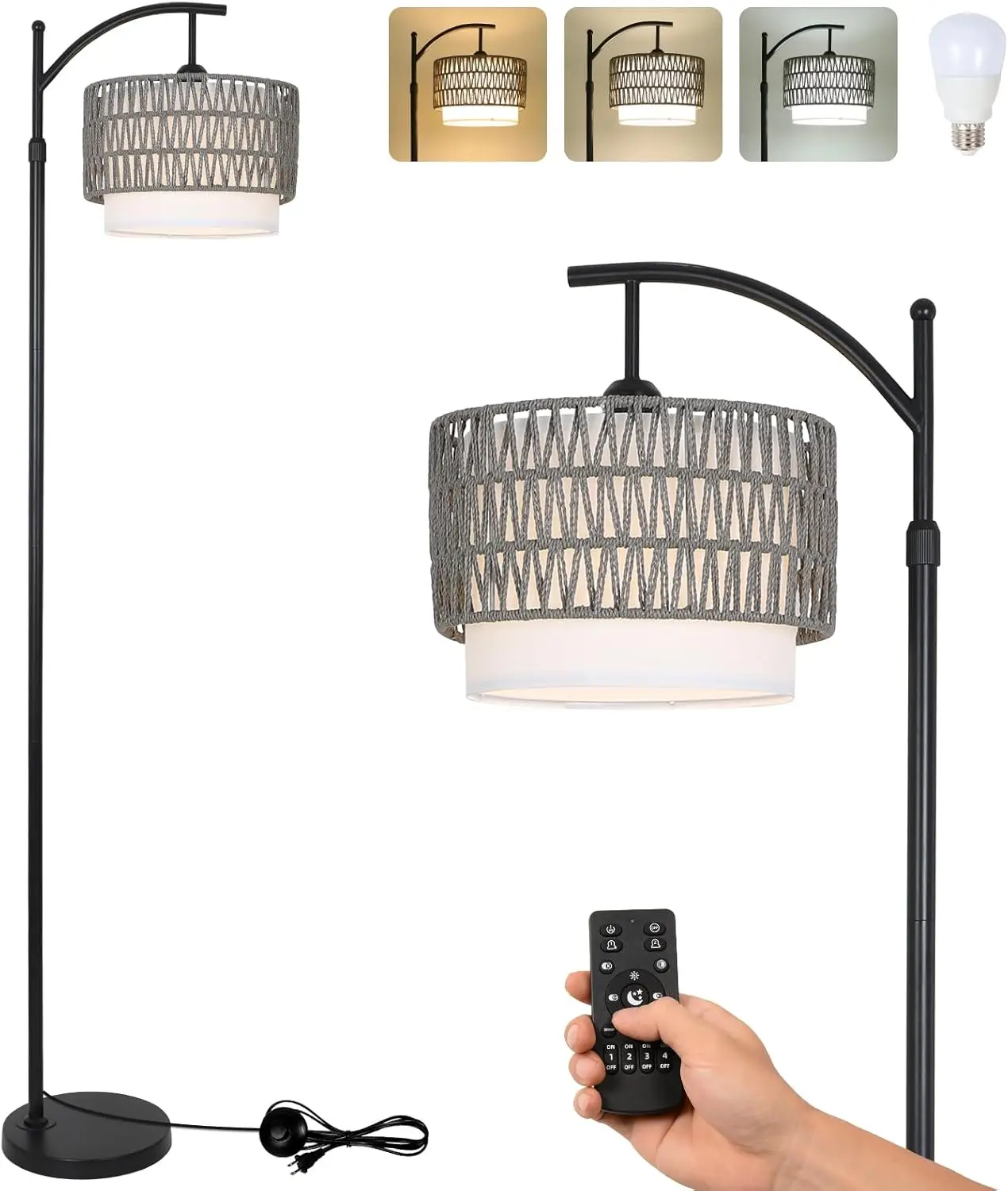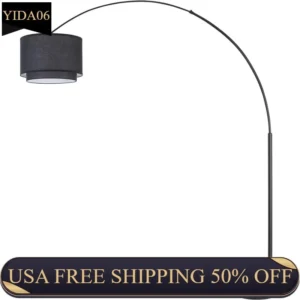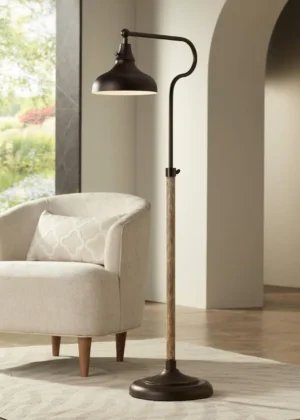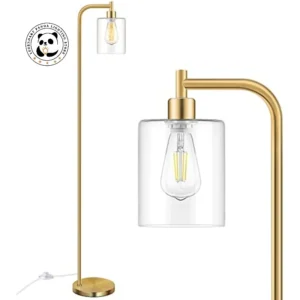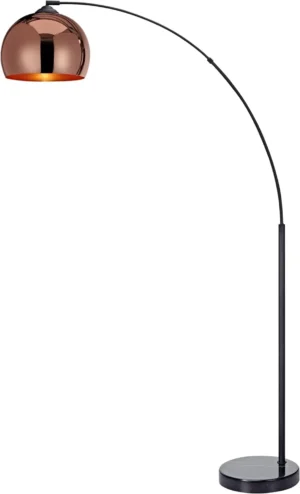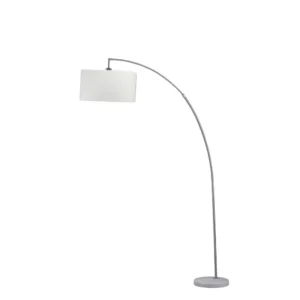Understanding Arc Floor Lamp Cord Challenges
Arc floor lamps present unique cord management challenges that standard lamps don’t share. Unlike table lamps or straight floor lamps, arc lamps have cords that typically need to span across open areas, creating both visual eyesores and potential tripping hazards. The distinctive curved design that makes these lamps so stylish also complicates cord control significantly.
Most arc floor lamps come with cords measuring 6-8 feet in length, which is necessary for reaching outlets but creates excess cord that needs management. The typical placement of these lamps—behind sofas, over dining tables, or in reading corners—often means the cord must travel across exposed floor space to reach the nearest wall outlet.
With heights typically ranging from 70-80 inches and arcs that extend outward 20-30 inches, these lamps create unique cord pathways that traditional cord management solutions aren’t designed to address. The curved metal or wood stems don’t naturally accommodate standard cord clips, and the distance from base to light source means cords are often visible along the entire structure.
Key challenges include:
– Cords that must cross open floor space to reach outlets
– Visible cords running along the curved arc, disrupting the lamp’s elegant profile
– Limited options for securing cords to the curved lamp structure
– Excess cord length creating bundle management issues
Choosing the perfect arc floor lamp can help minimize these challenges from the start, as some models feature more thoughtful cord routing. However, even the best-designed lamps will require additional cord management for a truly polished look.
These unique challenges require specialized solutions that address both safety concerns and aesthetic considerations. Proper cord management not only improves your space’s appearance but also eliminates tripping hazards while protecting your electrical cords from damage. Understanding specific techniques for hiding arc floor lamp cords will transform your lighting from a potential eyesore to a seamless design element.
Assessing Your Cord Management Needs
Before purchasing cord management accessories, take time to evaluate your specific needs. This assessment will help you identify the most effective solutions for your particular situation.
Consider these key factors:
– Aesthetics: How important is completely concealing the cord versus simply organizing it?
– Safety: Are there children, pets, or high-traffic areas where tripping hazards must be eliminated?
– Placement: Is your lamp near walls, or does it stand in an open area?
– Mobility: Do you need to move your lamp occasionally, or will it remain stationary?
– Outlet location: How far is the nearest outlet from your preferred lamp position?
Take a few minutes to map out the cord path from your lamp to the outlet. Measure the actual cord length and the distance to the outlet to determine how much excess cord you’ll need to manage. Also note any specific challenges along this path, such as crossing walkways or navigating around furniture.
Use this simple checklist to clarify your needs:
– [ ] Does the cord need to cross open floor areas?
– [ ] Is cord color contrasting strongly with floors or walls?
– [ ] Do you have excess cord length to manage?
– [ ] Are there children or pets who might pull on exposed cords?
– [ ] Do you rent your home (limiting permanent installation options)?
Your answers will help determine which solutions from the following sections will work best for your situation. Comprehensive cord organization tips for arc lamps can provide additional guidance on planning the most effective management strategy before purchasing any accessories.
Essential Wall & Baseboard Cord Concealment Options
When your arc floor lamp cord needs to run along walls or baseboards to reach an outlet, several effective concealment options can create a cleaner, more professional look.
Cord covers and raceways are among the most popular wall-based solutions. These channels come in various profiles and styles to match your decor:
- Rectangular cord covers: Typically 0.5-inch × 0.75-inch PVC channels that mount to the wall and completely encase cords
- Half-round cord covers: Lower profile option (about 0.5-inch height) that blends better with baseboards
- Paintable options: White plastic channels that can be painted to match your wall color exactly
Most wall-based cord covers use either adhesive backing or small screws for mounting. Adhesive options work well for rentals but may peel away from textured walls or in high-humidity environments. Screw-mounted versions provide more security but require drilling small holes.
For minimal cord runs or temporary solutions, adhesive cable clips offer a less intrusive alternative:
– Single-cord clips: Small plastic or metal holders that secure one cord against the wall
– Multi-cord clips: Larger versions that can organize several cords running in the same direction
– Decorative clips: Designer options in various finishes (brushed nickel, bronze, etc.) that turn cord management into a design element
When selecting wall-based solutions, consider:
– Color matching to your walls or baseboards
– Width capacity (ensuring it accommodates your lamp’s cord gauge)
– Corner pieces for navigating room transitions
– Ease of access for cord maintenance
The right tools for managing floor lamp cables can make installation significantly easier, particularly when working with longer cord runs. Most basic cord cover systems range from $10-30 depending on length and quality, making them an affordable solution for creating a polished look.
Floor Cord Protection & Concealment Systems
When your arc lamp cord must cross open floor space, low-profile cord protectors provide both safety and aesthetic benefits. These systems are specifically designed to minimize tripping hazards while blending with your flooring.
Floor cord protectors come in several varieties:
– Flat cord covers: Rubber or plastic channels with beveled edges, typically 0.25-0.5 inches in height
– Cord runner mats: Wider protective covers that can accommodate multiple cords
– Decorative cord covers: Designed to mimic wood grain or other flooring materials
The best floor cord protectors feature:
– Non-slip backing to prevent shifting
– Durable materials that withstand foot traffic
– Easy-open tops for cord access and maintenance
– Beveled edges to prevent tripping
For high-traffic areas, look for heavy-duty options rated to support furniture weight and withstand regular foot traffic. These typically have reinforced construction and can handle daily wear and tear without cracking or flattening the cord inside.
In living areas with rugs, consider rug-integration techniques:
– Under-rug cord channels: Ultra-flat guides designed specifically to route cords beneath area rugs
– Rug tape: Double-sided tape that secures both rug and cord to prevent shifting
– Edge-routing techniques: Methods to direct cords around rug perimeters rather than across them
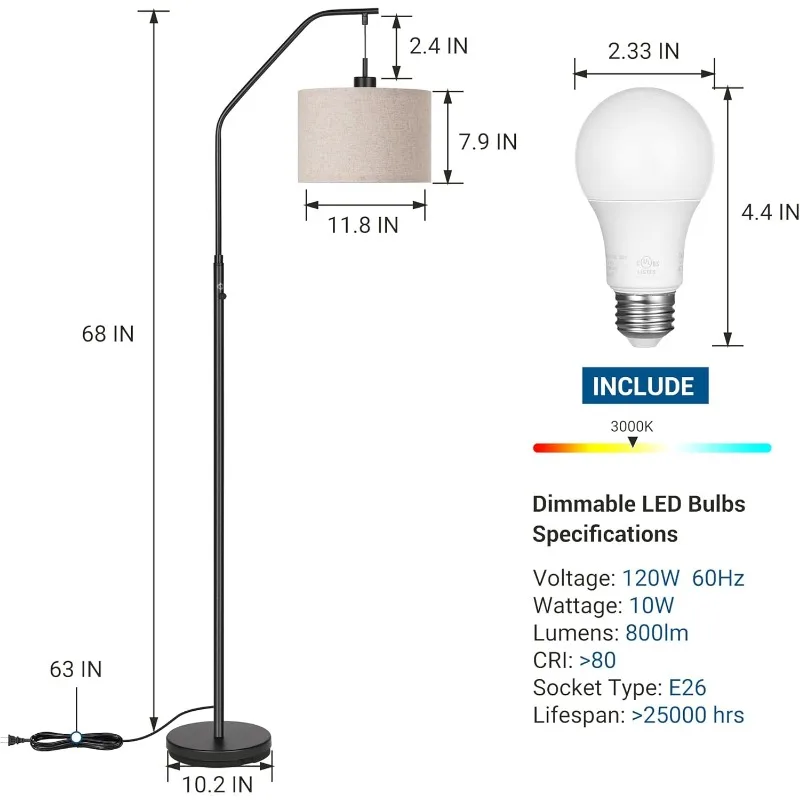
When selecting floor cord management systems, consider the cord’s path and choose solutions that create the most direct route possible. For maximum flexibility in cord placement, adjustable arc floor lamps allow you to position the light source optimally while minimizing cord exposure across open areas.
Safety tip: Always ensure floor cord protectors are securely placed and visible enough to prevent tripping while still maintaining an aesthetically pleasing appearance.
Managing Excess Cord Length & Outlet Area Organization
Even with perfect cord routing along walls and floors, most arc lamps have excess cord length that needs management. This section focuses on solutions for bundling excess cord and creating neat outlet areas.
Cord winders and shorteners provide simple but effective solutions:
– Rotating cord reels: Allow you to wind up 2-6 feet of excess cord
– Figure-8 cord wraps: Flat plastic devices that organize cord in a figure-8 pattern
– Velcro cord wraps: Reusable straps that secure bundled cords in any length
When selecting cord winders, consider:
– Capacity (how much cord length they can store)
– Accessibility for future adjustments
– Heat dissipation properties (tightly wound cords can generate heat)
For organizing the outlet area itself, cable management boxes offer elegant solutions:
– Covered boxes that completely hide power strips and adapters
– Dimensions typically range from 6 × 4 × 2 inches to 16 × 5 × 5 inches
– Available in wood, plastic, and metal finishes to match your decor
– Some include dividers for organizing multiple device plugs
When multiple cords share the same outlet area, consider:
– Color-coded cable ties for easy identification
– Cord identification tags to distinguish lamp cords from other electronics
– Multi-port power strips with individual switches for convenient control
Most of these solutions range from $5-40, making them affordable options for creating clean, organized outlet areas. For convenience and clean aesthetics, dimmable arc floor lamps often feature inline switches that eliminate the need to access the outlet area frequently, simplifying your cord management approach.
Heat management tip: Avoid excessive bundling of cords in enclosed spaces, as this can cause heat buildup. Allow some airflow around bundled cords, particularly near transformers or adapters.
Securing & Concealing Cords Along the Arc Lamp Structure
Managing cords along the actual arc lamp structure presents unique challenges due to curved surfaces and varying diameters. Specialized solutions can help integrate the cord seamlessly with the lamp’s design.
For securing cords to lamp poles:
– Curved-surface cord clips: Specifically designed to grip round poles from 1-2 inches in diameter
– Silicone cord managers: Flexible material that conforms to curved surfaces
– Spiral cord wraps: Flexible plastic that wraps around both cord and pole for integrated appearance
For concealing cords along the length of the lamp:
– Color-matched cord sleeves: Fabric or silicone covers that blend with lamp finishes
– Split-loom tubing: Flexible plastic tubing that opens along one side for easy cord insertion
– Heat-shrink tubing: For permanent installations where the cord won’t need future adjustment
When selecting these accessories, match materials and colors to your lamp finish:
– Brushed nickel clips for silver/chrome lamps
– Bronze or brass-tone accessories for warmer metal finishes
– Clear options for minimalist designs
– Fabric sleeves in complementary colors for designer lamps
The goal is to create a natural-looking cord path that follows the lamp’s structure without attracting attention. Properly secured cords not only look better but also prevent dangling cords that can be pulled or snagged.
For the sleekest appearance, black arc floor lamps often have black cords that naturally blend with the structure when properly secured against the lamp’s arc. This color coordination makes cord management significantly easier.
Installation tip: When attaching clips to lamp poles, position them at regular intervals (approximately 8-12 inches apart) and align them along the same line for the most organized appearance. Always ensure clips are secure but not clamping so tightly that they damage the cord’s insulation.
Integrating Cord Management into Interior Design
Effective cord management goes beyond simply hiding cords—it integrates solutions seamlessly into your interior design. With thoughtful approaches, cord control can become an unnoticed or even complementary element of your decor.
Strategic furniture placement offers natural cord concealment:
– Position sofas or console tables to shield cord paths from main sightlines
– Use bookcases or tall plants to disguise vertical cord runs
– Arrange furniture to create natural cord channels behind pieces
Color coordination makes a significant difference in cord visibility:
– Match cord covers to wall colors (white covers on white walls become nearly invisible)
– Select cord accessories in complementary colors to your design scheme
– Consider the floor/wall contrast when choosing floor cord protectors
Some designers even transform cord management into intentional design features:
– Geometric cord patterns created with decorative clips
– Architectural cord channels that complement modern interiors
– Custom-made cord covers in statement materials like brass or leather
Balance visibility with accessibility by:
– Creating removable cord management solutions where future changes might be needed
– Ensuring light switches and controls remain easily accessible
– Designing maintenance access points into more permanent installations
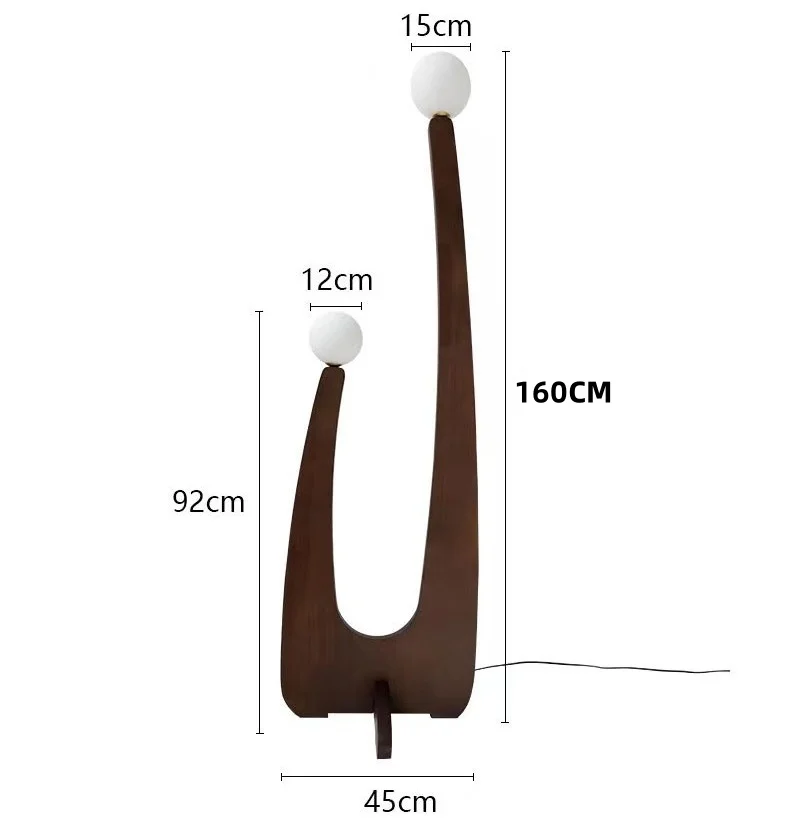
Professional designers often recommend:
– Establishing consistent cord management systems throughout the room
– Creating intentional cord paths that follow architectural lines
– Selecting cord management products from the same design family for cohesive look
For a truly integrated approach, modern arc floor lamps often feature design elements specifically intended to minimize cord visibility, including internal cord routing and base designs that naturally conceal cord exits.
DIY Cord Control Solutions for Arc Floor Lamps
Not every cord management challenge requires store-bought accessories. Many effective solutions can be created using common household items at minimal cost.
Simple DIY cord covers can be made from:
– Fabric cord sleeves: Created from fabric tubes in coordinating colors
– Painted cord channels: Basic PVC pipe split lengthwise and painted to match walls
– Decorative rope wrapping: Natural fiber rope wound around cords for a design feature
– Repurposed household items: Paper towel tubes, split and decorated for cord coverage
For wall routing without commercial products:
– Command hooks positioned strategically to elevate cords off the floor
– Decorative washi tape to secure cords in geometric patterns
– Picture rail systems repurposed for cord management
For managing excess cord:
– Toilet paper tubes for cord storage
– Customized cardboard cord winders
– Repurposed cable spools
Safety is paramount with DIY solutions. Always ensure:
– No sharp edges that could damage cord insulation
– Sufficient ventilation for heat dissipation
– No excessive bending or pinching of cords
– Materials are non-conductive and flame-resistant
Most DIY projects require minimal tools (scissors, adhesive, basic craft supplies) and can be completed in 15-30 minutes. While these solutions may not be as durable as commercial options, they offer customization possibilities not available in pre-made products.
When selecting an arc lamp initially, choosing the perfect arc floor lamp with good cord routing design can significantly reduce the complexity of your DIY cord management needs.
Installation Best Practices & Safety Considerations
Proper installation of cord management systems ensures both safety and longevity. Follow these best practices to achieve secure, effective results.
Before installing adhesive-based solutions:
– Clean surfaces thoroughly with isopropyl alcohol to remove dust and oils
– Allow surfaces to dry completely before applying adhesives
– Check temperature recommendations (most adhesives work best at 65-85°F)
– Test in an inconspicuous area first, particularly on painted or wallpapered surfaces
Essential tools for proper installation:
– Measuring tape for precise cord pathway planning
– Level for straight installation of cord channels
– Pencil for marking installation points
– Appropriate screwdriver for hardware mounting options
– Scissors or snips for cutting cord covers to size
Safety considerations for all cord management:
– Never exceed the bend radius recommended for electrical cords (typically no sharper than a quarter)
– Avoid placing cords under heavy furniture where they might be crushed
– Maintain at least 2 inches of space around any cord bundles for heat dissipation
– Inspect cord management systems regularly for wear or damage
– Never staple or nail directly into cords
⚠️ Warning: Never modify the electrical components of lamp cords themselves. Cord management should only involve organizing existing cords without cutting, splicing, or altering the electrical connections.
For households with children or pets:
– Select tamper-resistant cord covers with secure closures
– Use cord covers rated for chew resistance if you have pets
– Consider wall-mounted solutions rather than floor-based options where possible
– Select cordless options when appropriate for high-risk areas
Wood arc floor lamps often feature natural materials that require special consideration for cord attachment—avoid adhesives that might damage wood finishes and select clips specifically designed for wooden surfaces.
Top Accessories for Specific Arc Lamp Styles
Different arc lamp styles benefit from tailored cord management approaches. This section matches specific solutions to common lamp designs.
Minimalist Modern Lamps:
– Clear cord clips that virtually disappear against the lamp structure
– Thin-profile cord channels in matching metallic finishes
– Simplified cord paths with minimal attachment points
– Focus on reducing visual weight of cord management solutions
Traditional Arc Lamps:
– Fabric cord covers in complementary colors
– Decorative cord clips that enhance traditional aesthetics
– Wood-tone cord channels for coordinating with wooden elements
– Solutions that blend with classic design elements
Industrial Style Lamps:
– Exposed cord management that complements industrial aesthetic
– Metal cable clips and channels that match raw metal finishes
– Utilitarian solutions that align with functional design approach
– Cord wraps in leather or canvas for textural contrast
For Adjustable or Articulating Lamps:
– Flexible cord management solutions that accommodate movement
– Extra slack allowances at joint points
– Quick-release cord clips for easy reconfiguration
– Spiral cord wraps that expand and contract with lamp adjustments
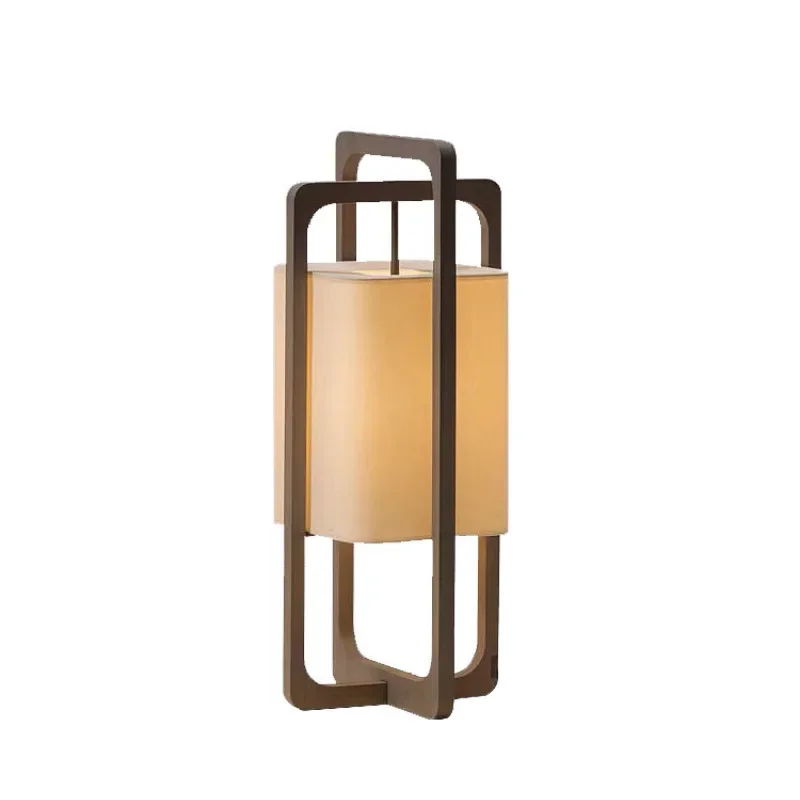
Size Considerations:
– Large lamps (over 80 inches tall): Require more attachment points along the arc
– Compact designs: Benefit from integrated cord management close to the structure
– Wide-arc lamps: Need solutions that can span greater distances
Minimalist arc floor lamps particularly benefit from sleek, low-profile cord management that maintains the clean lines of the design while effectively controlling cables.
Contemporary Arc Floor Lamp, Large Arc Floor Lamp, Oversized Arched Floor Lamp
$460.63 Select options This product has multiple variants. The options may be chosen on the product pageAdjustable Arc Floor Lamp, Bronze Arc Floor Lamp
Price range: $440.95 through $558.52 Select options This product has multiple variants. The options may be chosen on the product pageBrass Arc Floor Lamp, Contemporary Arc Floor Lamp, LED Arc Floor Lamp
Price range: $490.72 through $522.04 Select options This product has multiple variants. The options may be chosen on the product pageContemporary Arc Floor Lamp, Large Arc Floor Lamp, Marble Base Arc Floor Lamp
$224.94 Select options This product has multiple variants. The options may be chosen on the product pageMid-Century Arc Floor Lamp, Wood Arc Floor Lamp
$230.86 Select options This product has multiple variants. The options may be chosen on the product pageContemporary Arc Floor Lamp, Silver Arc Floor Lamp
$459.99 Select options This product has multiple variants. The options may be chosen on the product page
Frequently Asked Questions About Arc Lamp Cord Management
Q: Will attaching cord clips damage my lamp’s finish?
A: Quality cord clips designed for lamps use non-abrasive materials like silicone that shouldn’t damage most finishes. For delicate or painted surfaces, look for “finish-safe” labeled products and test in an inconspicuous area first.
Q: How do I manage cords with pets who chew on cables?
A: Pet-proof cord management includes bitter-tasting cord covers, rigid cord protectors made from chew-resistant materials, and elevating cords beyond reach. Braided metal cord covers provide the highest level of protection for persistent chewers.
Q: Can I paint over cord covers to match my walls exactly?
A: Many PVC and plastic cord covers are paintable. For best results, use a primer designed for plastic surfaces, then apply wall paint. Allow proper drying time between coats and before closing the cord cover.
Q: Do cord management solutions affect the electrical safety of my lamp?
A: Properly installed cord management shouldn’t compromise safety if it doesn’t pinch, bend sharply, or overheat cords. Avoid excessively tight bundling that can trap heat, and never modify the cord itself.
Q: How often should cord management systems be inspected?
A: Check cord management systems every 3-6 months and whenever furniture is moved. Look for wear points, loose attachments, or damage to the cord’s insulation.
Can Arc Lamp Cords Be Completely Hidden?
While perfect invisibility is challenging, arc lamp cords can be concealed to the point of being virtually unnoticeable with the right approach. Complete concealment typically involves trade-offs between visibility, accessibility, and installation complexity.
The most comprehensive concealment approaches include:
– In-wall cord routing (requiring professional electrical work)
– Under-floor channeling beneath area rugs
– Integration with architectural elements like crown molding
– Custom furniture solutions with built-in cord channels
These approaches offer the most invisible results but come with considerations:
– Permanent installations limit future flexibility
– Professional installation increases cost ($150-500 depending on complexity)
– Access for maintenance becomes more difficult
– Some solutions may not be feasible in rental properties
For most situations, a balanced approach works best:
– Concealing the most visible portions of the cord
– Creating intentional, neat cord paths for less visible sections
– Matching cord management colors to surroundings
– Using furniture placement strategically
Remember that some degree of cord visibility is normal and acceptable in most home environments. The goal should be minimizing visual disruption rather than achieving complete invisibility at the expense of practicality or safety.
Are Wireless Arc Floor Lamps a Viable Alternative?
Battery-powered arc floor lamps represent an emerging solution to cord management challenges. These lamps eliminate cords entirely but come with their own set of considerations.
Current wireless arc lamp technology offers:
– Run times of 8-12 hours on a full charge (varies by brightness setting)
– Rechargeable lithium-ion battery systems
– Brightness levels comparable to standard corded options
– Modern designs that integrate battery components discreetly
The primary advantages include:
– Complete elimination of cord management issues
– Flexible placement anywhere in a room
– Clean, minimal aesthetic without cord distraction
– Safety benefits with no tripping hazards
However, significant limitations remain:
– Price premiums of $150-300 over comparable corded models
– Need for regular recharging (typically every 1-3 days)
– Limited brightness options to conserve battery life
– Added weight (2-5 pounds) from battery components
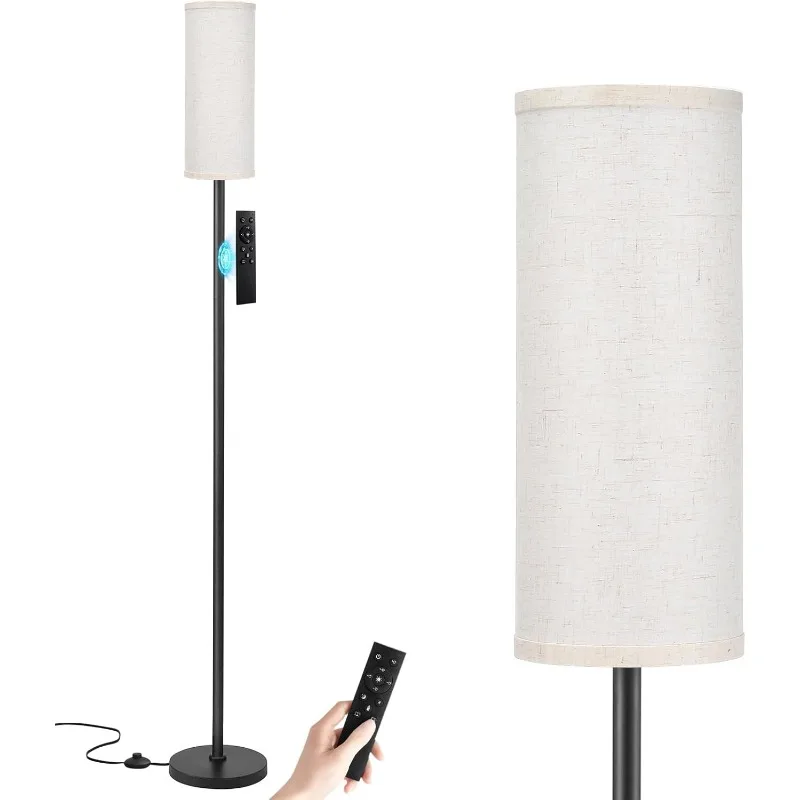
For many users, the convenience of wireless operation justifies these trade-offs, particularly in:
– Rooms without convenient outlet access
– Settings where furniture is frequently rearranged
– Minimalist designs where even well-managed cords detract from the aesthetic
As battery technology continues to improve, wireless options will likely become more practical and affordable. For now, they represent a premium solution for those who prioritize complete cord elimination over other factors.
How to Choose the Best Arc Lamp Cord Management System
Selecting the ideal cord management approach requires balancing several key factors. This decision framework will help you identify the most appropriate solutions for your specific situation.
Prioritize your primary concerns:
1. Safety (preventing trips and electrical hazards)
2. Aesthetics (minimizing visual disruption)
3. Accessibility (ease of maintenance and adjustment)
4. Budget (cost-effective solutions)
5. Installation complexity (DIY-friendly vs. professional)
Consider your living situation:
– Rental properties: Focus on non-permanent solutions that won’t damage surfaces
– Owned homes: Balance temporary and permanent options based on long-term plans
– Homes with children/pets: Prioritize tamper-resistant, durable solutions
– Frequently redesigned spaces: Select flexible, reusable cord management
Combine approaches for comprehensive results:
– Wall-based solutions for perimeter routing
– Floor protection for necessary crossings
– Lamp-specific attachments for the arc itself
– Outlet area organization for excess cord
For most situations, a layered approach works best—addressing different segments of the cord path with specialized solutions rather than seeking one perfect product. Start with the most visible or hazardous sections first, then address less critical areas as budget allows.
Remember that the best cord management system is one that meets your specific needs while complementing your interior design. With thoughtful selection and proper installation, you can transform cord chaos into organized elegance that enhances the beauty of your arc floor lamp.
Interior Ivy offers a curated selection of arc floor lamps with innovative designs that minimize cord visibility and simplify management. Exploring options with built-in cord routing features can significantly reduce the need for extensive aftermarket solutions.

